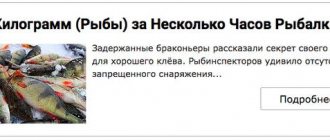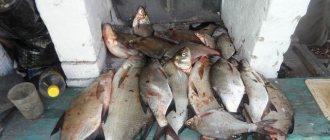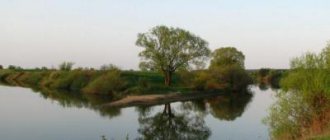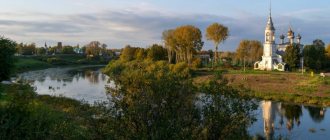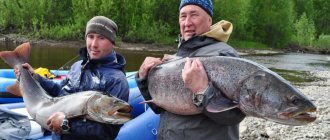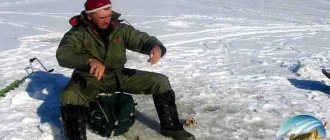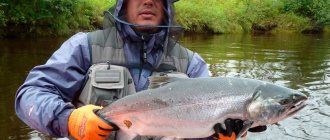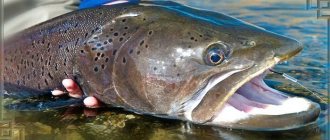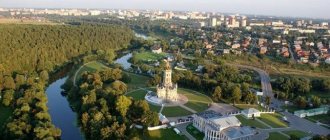Many residents of the Leningrad region are familiar with the Svir River, which flows in the northeastern part of the region. This body of water attracts a large number of lovers of water tourism, active recreation and, of course, fishermen.
Fishing on the Svir has always been famous among residents of the Leningrad region. Probably every self-respecting fishing enthusiast has visited this body of water at different times of the year, tried a variety of gear and fishing methods, and caught some fairly heavy underwater inhabitants.
Description of the reservoir
The Svir is considered a large lowland river that flows in the northeastern part of the Leningrad region of Russia along the border with the Republic of Karelia.
Has the following main characteristics:
- channel length – 224 km;
- water basin area – 84,000 sq. km;
- water consumption – 785 cubic meters. meters per second;
- width from 100 meters to 10–12 km;
- average depths – 4–5 meters;
- the slope is directed in a westerly direction.
The Svir originates from Lake Onega near the village of Voznesenye. It flows into Ladoga, the mouth is located near the village of Sviritsa in the Volkhov district of the Leningrad region. The river is an important element of the Volga-Baltic waterway.
The Svir River plays an important role in the life of the Leningrad region
The riverbed of the Svir is almost straight, without sharp turns. It takes place in the lowlands. The banks are hilly and covered with forest. In its lower reaches, the river forms a forked delta, saturated with channels and branches, one of which is connected with Zagubskaya Guba.
Previously, there were rapids in the middle reaches of the Svir, but after the construction and commissioning of the Svir hydroelectric power station cascade, the water level in the river rose, it became deeper and is now navigable along the entire channel, from source to mouth. A notable place on the reservoir is the Ivinsky Razliv, Verkhnesvirsky hydroelectric complex.
Shipping is developed on the Svir River
The Svir is distinguished by a pronounced asymmetric basin, in which the left tributaries significantly dominate over the right ones. Among the first, Oyat and Pasha stand out. It is worth mentioning the rivers Kuzra, Svyatukha, Shamoksha, Pogra and Shotkusa. From the right they flow into its channel:
- Muromlya;
- Ivina;
- Pidma;
- Vazhinka;
- Mandroga;
- Uslanka;
- Segezha.
The river is fed 80% by Lake Onega. The water regime is stable throughout the year, thanks to the Svir hydroelectric power stations. The reservoir has important transport significance. Passenger and transport flows pass through it, and timber is floated.
This is interesting: Upper Pigmozero: fishing and what kind of fish is found
What kind of fish live
In the Svir River there are many species of fish that live in Lake Onega and Lake Ladoga. Despite the unfavorable conditions due to the constant operation of the hydroelectric gates, she has adapted to the local changes and feels quite comfortable.
There are many promising points on the Svir where you can expect to meet a hefty fish
The main inhabitants of Svir are:
- salmon representatives of the ichthyofauna;
- pike and perch;
- burbot and pike perch;
- asp, ide and chub;
- grayling and minnow;
- bream and roach.
Catfish are found in deep areas. There is also whitefish in the reservoir, but its fishing is prohibited all year round. Other fish can be hunted in the area of populated areas.
Spring and summer
The Svir River in the Leningrad Region is famous for its excellent fish trophies brought from its tributaries. So, roach, ide and salmon always bite on Oyati. At the beginning of June, pike perch fish well on the river, even though the water is still cloudy. In July, perch and pike begin to bite, which is also actively caught in August. It is in this month that the rainy season begins. But pike perch are no longer so active and are rare.
In the tributary of the Syas River, ide, catfish, asp and grayling are caught.
A rule that experienced fishermen adhere to: if the fish are not biting on the river, then you should immediately go to the tributaries.
In the area of the Gakruchya tract there are many bays, bays and creeks. There are islands, including floating ones. The fishing here is good for ide, perch, roach and bream. The ide on the Svir River, a photo of which is in the article, can reach 1.5 kilograms. And pike can be caught up to 10 kilograms.
Below Gakruchya, about 3-4 kilometers, perch is caught well and you can meet large humpback salmon weighing up to 600 grams.
In the area of the village of Plotichno and near the tributaries of the Selga and Rzhanaya rivers you can catch bream and roach, and rudd. There are many so-called perch boilers here. It is in these places that the perch catches small things and there is a chance to catch individuals up to 800 grams.
Hydrological regime
The Svir River has a length of 224 km. Its height at the source is 35 m, at the mouth – 4.84 m.
Water flow – 785 m3/s. The width along its entire length varies from 100 m to 10-12 km (Ivinsky Razliv).
The water regime of the river is uniform throughout the year. About 80 percent of the watershed falls on Lake Onega.
The soil mainly consists of stones and clay, with some sand and silt. There are many places on the Svir with a predominant rocky bottom.
There used to be rapids in the middle part of this body of water, but after the construction of a cascade of power plants they were flooded. Now a deep-sea path has been created along the entire length of the channel.
Depending on weather conditions, ice appears on the Svir for a period of 3-6 months. The stages of its formation and opening in different areas due to individual characteristics proceed in a variety of ways. The first ice forms in November-December and disappears in April-May. In warm years, as well as in places with strong currents, a continuous cover may not form.
Fishing on the river
3
You can fish on the Svir River in different ways, but the most popular are spinning and donka. Some anglers prefer the float direction. In winter, they mainly use rigs and rigs, as well as heavy jigs or bottom rigs.
It is worth noting the peculiarities of catching salmon species. Their fishing is permitted in the following areas:
- From the mouth to the Nizhesvirskaya hydroelectric station, using bottom and float fishing rods without restrictions. It is prohibited to fish with spinning rods from May 15 to June 15, and from October 1 to November 30.
- Above the dam of the Nizhesvirsky hydroelectric complex, there are no more than 10 hooks per fisherman for a float and a donk all year round. You can fish with spinning rods from May 20 until the start of the spawning ban.
- From the mouth to the village of Alekhovshchiny, use a float rod with a maximum of five hooks per person.
The main methods of catching predatory fish on the Svir River are spinning fishing methods and bottom live bait gear. Of the artificial baits, the best results are shown by silicone and oscillating spoons; you can also use front-loaded spinners and deep-sea wobblers.
In winter, girders can be placed in calm sections of the river
Peaceful fish are caught with donks and float rods. Among the first popular ones are banal snacks, rubber bands, and weights. Experienced fishermen use feeder gear. The best baits on the Svir are a bunch of bloodworms, a red worm and maggots.
River Svir fishing
The Svir River flows in the Leningrad region, the river flows from Lake Onega and flows into Lake Ladoga.
33 km from the source the river spills into Ivinsky Razliv
The length of the Svir River is 224 km. The width of the Svir River along its length varies from 100 meters to 10-12 kilometers (Ivinsky Razliv).
The current speed in the river , in different sections, is from 0.5 km/h to 10.6 km/h .
The Verkhnesvirsky (120 km from the mouth) and Nizhnesvirsky (80 km from the mouth) hydroelectric complexes were built on the river; they divide the river into three sections: Lower Svir (80 km), Middle Svir (45 km) and Upper Svir (95 km).
The Verkhnesvirsky reservoir formed the Ivinsky Razliv with an area of 183 km².
The river is covered with ice for a period of 3-6 months. The river begins to freeze in November-December, the ice disappears completely in April-May. Spring ice drift on the upper reaches of the Svir occurs twice. First, the river itself is freed from spring ice, then ice from Lake Onega flows along it, the interval between ice drifts is 2-4 weeks.
The Svir River is navigable, along the entire length of the river, the depth in the fairway area is from 4 to 15 meters.
Fish: salmon, pike, pike perch, perch, catfish, grayling, burbot, asp, ide, chub, bream, minnow, bluegill, roach, etc. The work of the locks is noticeable along the entire length of the river, the water level changes dramatically. Ebbs and flows occur many times a day. The banks are either flooded or dried up. Nevertheless, the fish population adapts to these unfavorable conditions and there is a lot of fish in the river. Whitefish fishing is prohibited in the Svir River throughout the year. Fishing for other species of fish in the river is permitted only near populated areas.
Fishing for salmon species is permitted: 1) from the mouth to the 500-meter restricted zone of the Nizhne-Svirskaya hydroelectric power station (donka and float without restrictions on fishing periods, spinning fishing is allowed except for the periods from October 1 to November 30 and from May 15 to June 15) ; 2) along the entire length of the river, excluding the 500-meter prohibited zones of bridges and dams (ice fishing for burbot is allowed with two single-neck meshes up to 2 m long with a hoop diameter of 0.5 m); 3) above the dam of the Nizhne-Svirskaya hydroelectric power station by 500 m and further along the entire length of the river (fishing is allowed with a float rod with no more than 10 hooks and you can fish with a donkey without any restrictions on the timing of fishing, fishing with a spinning rod is allowed from May 20); 4) from the mouth to the village of Alekhovshchina (fishing is allowed with a float rod without restrictions on the place of fishing and the timing of fishing; fishing rods of no more than 5 units per fisherman are allowed from the beginning of the ice melting until July 1).
Tributaries About 30 rivers flow into the bed of the Svir and Ivinsky Razliv rivers, the largest and most important of them are Oyat, Pasha, Vazhinka, Ivina, Yandeba. The Pasha and Oyat rivers are navigable in the lower part. At the mouth of the Svir River, the Novo-Svirsky and Staro-Svirsky canals (Staro-Ladozhsky and Novo-Ladozhsky canals) adjoin on the left side. Left tributaries of the river: Yanruchey, Svyatukha, Bolshaya Kuzra, Toiba, Meldusa, Shakshozerka, Svyatukha, Pogra, Yandeba, Mungala, stream. Ludanka, Yanega, Kanomka, Shamoksha, Shotkusa, Oyat, Pasha, Kislaya Oyat. The right tributaries of the river: Shavreka, Muromlya, Ivina, Pidemka, Pidma, Vazhinka, Uslanka, Mandroga, Negezhma, Tenzeya , Rudeya, Irvinka, Segezha, Korelka, Lisya.
There are about thirty small and low islands in the riverbed.
Water body code – 01040100712102000011922 Hydrological study code – 102001192 River length – 224 km.
Source : Lake Onega, Voznesenye village, Podporozhsky district, Leningrad region. Coordinates: 61°0′47.22″ N. latitude, 35°29′17.9 in. d. Estuary : Lake Ladoga, Sviritsa village, Lodeynopolsky district, Leningrad region. Coordinates: 60°30′9.94″ N. latitude, 32°48′12.55″ e. d.
Tourism and rest
In addition to electrical energy, residents and guests of Moscow and St. Petersburg can go on excursions. There are three stops along the river cruise:
- Svirstroy.
- Lodeynoe field.
- Mandrogi.
From the Svirstroy parking lot, which is located near Lodeynoye Pole, bus tours to holy places depart, namely to the Holy Trinity Alexander Svirsky Monastery. By the way, the temple was erected in 1484 and it contains the relics of Svirsky Alexander.
But the Svir River is famous not only for spiritual excursion tours. Vacationers can visit the Vepsian Fair.
And at the Mandrogi stop there is a so-called Green parking lot. Here, in the village of Verkhnie Mandrogi, an ethnic settlement has been organized, where you can see the life of the ancient Slavs and try Russian entertainment.
Despite the formidable rapids, the village has a place for swimming, the opportunity to ride horses, taste traditional Slavic cuisine, visit a mini zoo and a museum of Russian vodka.
And this is not all the entertainment for which the river is famous. This body of water is very popular among fishermen.
On the banks of the Svir River there are many recreation centers where you can have a wonderful vacation or weekend, go fishing, visit holy places and take a walk in the forest.
The Svirskaya recreation center is located 4 kilometers from Lake Ladoga, on Svir. The main direction of the establishment is the organization of fishing. Also available to vacationers are comfortable cottages and “Hunting with a huntsman.” This is a seasonal hunt in the Gornyak, Zagubskaya Guba, Mezhkanalye areas, etc. for wild boar, ducks, hares. The base is located in the Volkhov region, in the village of Sviritsa.
Not far from the village of Verkhnie Mandrogi on the bank of the river, in the village of Svirstroy (240 km from St. Petersburg), there is a cottage complex “Cozy Pier”. There are 3 cottages at a distance from the river from 10 to 60 meters. In addition to fishing, here you can barbecue, sunbathe, ride a bike and go mushroom picking.
In the village of Kondratyevo in the Zagubskaya Guba tract there is a fishing base “Coast of Luck”. There are several comfortable cottages on the banks of the Svir River.
The Russian North and the Svir River are inextricably linked. Even despite the anthropogenic impact, the river is still one of the most fishy in Russia.
If you come for fishing in the Svirskaya Bay of Lake Ladoga, people call it the village. Sviritsa or the Svir River, then after the day’s catch, in the evening, load the boat onto a trailer and drive 21 km towards Lodeynoye Polye to our village complex “Farmer”, village.
Domozhirovo. Park your car and trailer with your boat in our secure parking lot and relax in our inexpensive campsite.
After fishing, you can order a sauna with a plunge pool (sauna and camping must be booked in advance), and also enjoy dishes made from natural farm products in our restaurant.
Having rested the night at the campsite after the bath, in the morning with renewed vigor go into battle with large pike perch and pike perch, but before fishing, do not forget to eat a hearty breakfast in our Farmer store and buy some “snacks” with you - to have a snack while fishing.
Reservations and orders for paid fishing are accepted by phone, Alexey
PRICE LIST
| Equipment rent | Price per service |
| PVC boat Poseidon - 520 with equipment and Yamaha engine - 40 hp. | Daylight hours 6 hours - 8,000 rubles, each additional hour 1,500 rubles. |
| Life jackets | For free |
| Landing net | For free |
Upon arrival at our complex, you receive a 10% discount card, which gives you the right to a discount on the products of the restaurant, store, as well as all services of the complex: motel, tire service, shooting range, service station, sauna with plunge pool. With us you can always buy fresh products to take with you when fishing and on the way home.
For questions about additional services, please call
paid fishing is reserved in advance so that we can prepare for your arrival. Call now 8(921)414-27-07 to reserve your desired dates.
This is interesting: Verkhnetulomskoye Reservoir: fishing and what kind of fish is found
Rest on the river
In addition to electrical energy, residents and guests of Moscow and St. Petersburg can go on excursions. There are three stops along the river cruise:
- Svirstroy.
- Lodeynoe field.
- Mandrogi.
From the Svirstroy parking lot, which is located near Lodeynoye Pole, bus tours to holy places depart, namely to the Holy Trinity Alexander Svirsky Monastery. By the way, the temple was erected in 1484 and it contains the relics of Svirsky Alexander.
But the Svir River is famous not only for spiritual excursion tours. Vacationers can visit the Vepsian Fair. And at the Mandrogi stop there is a so-called Green parking lot. Here, in the village of Verkhnie Mandrogi, an ethnic settlement has been organized, where you can see the life of the ancient Slavs and try Russian entertainment. Despite the formidable rapids, the village has a place for swimming, the opportunity to ride horses, taste traditional Slavic cuisine, visit a mini zoo and a museum of Russian vodka.
And this is not all the entertainment for which the river is famous. This body of water is very popular among fishermen.
Spawning prohibitions for fishing on the Svir
Along the entire length of the Svir River, fishing is permitted with all fishing gear, except for those prohibited by fishing rules.
Exceptions are these sections of the river:
- Section: The water area of the Nizhne-Svirsky Nature Reserve from the mouth of the Svir River to the border of the Leningrad region with the Republic of Karelia - there is a year-round fishing ban!
- Section: Svir River - from the mouth to the 500-meter restricted zone of the Nizhne-Svir hydroelectric power station. Allowed: Float fishing rod (without time limit), donka (without time limit), spinning rod (except for the periods from May 15 to June 15 and from October 1 to November 30).
- Section: Svir River: throughout the upstream 500-meter zone of the Nizhne-Svirskaya HPP dam. Allowed: Float fishing rod (no time limit), donka (no time limit), reel (no more than 10 hooks), spinning rod (from May 20 until freeze-up).
- Fishing with spinning tackle is prohibited from May 15 to June 15, as well as from October 1 to November 31.
- Anglers are allowed to catch no more than 5 girders per person from the melting of the ice until June 1.
- It is prohibited to catch whitefish on the river throughout the year, and other species can only be caught near populated areas.
- Under-ice fishing for burbot with single-neck meshes no more than 2 meters long is permitted almost along the entire length of the river, except for some restricted areas, bridges and dams.
See: Spawning bans and fishing rules
See: Fishing on the Svir River - fishing with wire
About fishing in the Svir River
> Where to fish > Reservoirs of the Leningrad region and surrounding areas > About fishing in the Svir River
The Svir is the most beautiful river in the Leningrad region, with rich fish stocks and connecting Lakes Onega and Lake Ladoga. Today on this river there are two hydroelectric stations “Svir-3” Nizhne-Svirskaya located slightly above the Lodeynoye Pole railway station belonging to the Murmansk railway and “Svir-2” Verkhne-Svirskaya located near the Pogra station.
Svir is divided by hydroelectric dams into three sections with numerous rifts and porges. Fishing on the Svir
and today it pleases many fishermen. However, in the 80s of the last century, the number of catches by an experienced fisherman, and often by an inexperienced fisherman, was much greater than in our time. The situation has changed significantly since then, but unfortunately not for the better. Currently, in order for fishing in this river to be successful, you need to seriously prepare for it, as well as have reliable information about the time and places of fishing.
Fishing in Svir
It is carried out almost everywhere, but there are not so many really catchy places on this river. One of the best fishing places in Svir is its mouth. If you sail along the river from Ladoga, at the exit you can see a small island, between this island and the shore there is a fairway along which ships move. In these places, however, as throughout the river, you should be very careful about the ships that constantly pass here before the onset of winter.
As for the bottom, it is mostly sandy and has a fishing depth, excluding the fairway at about 4 meters. The main fish caught in Svir are bream, pike, silver bream, perch, roach, and less commonly pike perch. Regarding perch fishing in Svir
, then here it does not gather in large flocks and fishing for it is difficult. But perch can be caught here almost everywhere and always. It is best to catch striped fish in these places using the jig method, however, the track, if you use a small wobbler, brings good results. The best parking spots here are on Fox Island off its right bank. The island is covered with numerous sandy beaches. But there is a problem with firewood, and if you fish on the island, it is better to take the firewood with you. Behind the sandy strip the swamps begin. But there are few mosquitoes here because the island is well blown by winds.
Previously, before the construction of dams for the Svir, salmon fish such as trout, brown trout and grayling were not uncommon. But even today they have not disappeared completely, just the number of these fish in the river has decreased. So the first section, stretching from Ladoga to the dam of the Nizhne-Svirskaya hydroelectric station, is still inhabited by these species of fish. In addition, next to the dam there is a fish factory where Ladoga salmon is bred.
Fishing in the Leningrad region on the Svir from the shore is of course less productive than from a boat, however, sometimes you can get a good catch from the shore. They catch mainly from the shore silver bream, roach, perch and, less commonly, bream and bream. But on Fox Island you can do excellent fishing with bottom tackle and cast a spinning rod.
The area between the two hydroelectric power stations is isolated from both Lakes Ladoga and Onega. The fishing here is excellent for perch, roach, bream and large pike. There is also its own variety of salmon, which spawns near the dam of the Verkhne-Sivirskaya hydroelectric power station.
At the mouth of the Yandeba River, a tributary of the Svir, however, and upstream there are very attractive places for fishing, and besides, these places are also very beautiful and picturesque. Yandeba is characterized by a steep fall and the higher the intersection of the river with the highway, the less backwater. In the spring , fishing in
the Leningrad region in the Yandebe River
is for large grayling.
As for the third section located above the Verkhne-Svirskaya hydroelectric station, the conditions are quite different due to the fact that the station’s backwater extends to Lake Onega. There is also salmon here in small quantities.
Verkhne-Svirskoye is a huge but shallow lake; significant depths are present only in the old channel. The entire flooded area of the reservoir was carefully cleared of forest and bushes before flooding and is very interesting for fishermen, since it has not yet been developed by either industrial or sport fishing. In terms of fishing, the mouth areas of tributaries are of significant interest, where in clear and cold water you can quite often find fish such as grayling, ide, and brook trout. Most likely, this salmon was once forced out of the old channel of the Svir.
There are no problems with renting boats on Svir; for a boat, an outboard motor is needed in the lower section, where there is a fast current. Moreover, a motor is necessary in the spacious upper sections of the reservoir. The big advantage of this river and its tributaries is that there is not a single enterprise that pollutes the water. The water is clean and very transparent everywhere.
Winter fishing in the Leningrad region on the Svir River
as very interesting and varied as willow in the summer. After freeze-up on the river and there is an opportunity to go fishing at the mouth, a large number of winter fishing enthusiasts flock to these places. The real hunt for perch begins.
As a rule, perch fishing is carried out either on the riverbed itself or at the outlet near Fox Island. On the riverbed itself, as a rule, perch is caught by trolling. Other methods are ineffective due to the strong current. Spoons are usually weighted. There is no current only near the shore, where the depth is no more than two meters.
However, even here quite large individuals are caught at a depth of about 40 cm. Bream are often caught here as by-catch. At the exit, the depth often reaches 4 meters or more, the current here is not very strong and fishing with a jig is quite possible here. There is a significant amount of pike here, which bite well, the only problem is how to get live bait. Since catching him in this place is very problematic. Also an excellent place for fishing for spotted predator using such gear as a zherlitsa is Zagubskaya Bay. But the problem is that it is practically impossible to catch live bait here. You can fish in other places, but these are the most catchy ones.
This river, with its exceptionally picturesque and sparsely populated banks, is an interesting place for both fishing and family recreation.
Published: 01/23/2015
Other interesting materials:
| The best places for fishing in the Kuban Many fishermen know firsthand that the Krasnodar region is a great place for fishing... | Is it possible to catch trout in the Caucasus and Krasnodar Territory? The answer is yes. But not everywhere and not always. But in the central regions... | Ide has become a rarity. This fish has really begun to appear in our reservoirs... | Fishing in the freshwater reservoirs of Abkhazia Abkhazia is famous not only for its sea fishing, but also for fishing in… |
general characteristics
The length of the Svir River is 224 kilometers. The source of the river is Lake Onega. In the area where the village of Voznesenskoye is located there is the mouth of Lake Ladoga. The area of the river basin is 84,400 thousand square meters. km. The width of the river ranges from 100 meters to 12 km. The entire course of the reservoir is located in the Leningrad region.
The average depth of the reservoir in the lower and upper reaches is up to 4 meters. In the lower reaches it reaches 7 meters.
The river and Ivinsky Razliv have many tributaries, about 30. The largest are:
- Oyat;
- Vazhinka;
- Pasha;
- Ivina;
- Yandeba.
On the left side of the river there are the Staro-Svirsky and Novo-Svirsky canals.
The mouth of the river has about 30 islands of different sizes.
History of the Svir River
The reservoir was always not deep and had multiple rapids, so there was no navigation here. With the advent of Soviet power, around the 30s of the last century, a decision was made to create a cascade of hydroelectric power stations. This would satisfy the area's electrical energy needs and create a deep-sea route to allow ships to navigate the entire length of the river.
As a result, the Nizhne-Svirskaya hydroelectric power station is being built near Ladoga. The Verkhne-Svirskaya hydroelectric power station was built not far from Onega. As a result of the construction of this station, the Ivinsky Razliv, or Verkhne-Svirskoye Reservoir, appeared. The reservoir reaches all the way to Lake Onega, which raised it to its level.
Both stations are equipped with gateways, which allows for vessel traffic in both directions.
Fishing bans
There are some restrictions on fishing on the Svir River.
Fishing for whitefish is prohibited throughout the entire water basin.
You can fish near populated areas. There are also certain catch restrictions. They are shown in the table below.
| What is possible | What not to do |
| Salmonidae | |
| The catch was 500 meters from the end of the restricted zone of the Nizhne-Svirskaya hydroelectric power station. You can use donka or floats as gear | Spinning fishing is prohibited from 01.10 to 30.11 and from 15.05 to 15.06. No more than 5 units per person |
| Burbot | |
| Everywhere except the 500-meter zone near dams and bridges | Ice fishing is permitted, but subject to the use of no more than two single-neck meshes (2 meters, with a hoop diameter of 50 centimeters) |
You can fish from the shore, or you can use a swimming device. Naturally, the second method is preferable, since the probability of getting a good catch increases several times.
Winter fishing
Freeze-up on the reservoir begins from the end of November-December. And ice breaking up occurs from the end of April to the end of May, depending on the location and the presence or absence of currents.
In some places where the current is particularly strong, the river is not covered with ice at all. In the lower part of the river, there may be jams that raise the water level up to 3.3 meters.
And at the mouth there are often polynyas of different sizes, so you should be careful.
During the winter season, bass anglers flock to the mouth of the river in the area of the riverbed near the red building. Here you can only fish with a vertical spoon, preferably a heavy one, as the current is strong.
Also the second popular place is the exit near Fox Island. In addition to perch, you can catch bream.
At the exit from the channel, where the depth is already 4 meters, you can fish with a jig. And you can already catch a pike.
By the way, pike is also caught well in winter on the left bank of the river in Zagubskaya Bay. Other places are also full of fish, but these are the most popular.
Recreation and fishing
On the banks of the Svir River there are many recreation centers where you can have a wonderful vacation or weekend, go fishing, visit holy places and take a walk in the forest.
The Svirskaya recreation center is located 4 kilometers from Lake Ladoga, on Svir. The main direction of the establishment is the organization of fishing. Also available to vacationers are comfortable cottages and “Hunting with a huntsman.” This is a seasonal hunt in the Gornyak, Zagubskaya Guba, Mezhkanalye areas, etc. for wild boar, ducks, hares. The base is located in the Volkhov region, in the village of Sviritsa.
Not far from the village of Verkhnie Mandrogi on the bank of the river, in the village of Svirstroy (240 km from St. Petersburg), there is a cottage complex “Cozy Pier”. There are 3 cottages at a distance from the river from 10 to 60 meters. In addition to fishing, here you can barbecue, sunbathe, ride a bike and go mushroom picking.
In the village of Kondratyevo in the Zagubskaya Guba tract there is a fishing base “Coast of Luck”. There are several comfortable cottages on the banks of the Svir River.
The Russian North and the Svir River are inextricably linked. Even despite the anthropogenic impact, the river is still one of the most fishy in Russia.
